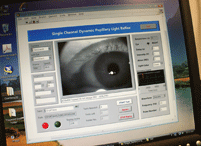 Using a newly-developed pupillary response test that is 92.5% accurate, researchers from the University of Missouri have demonstrated that children with autism have slower pupillary responses to light. Results were published in the November issue of Journal of Autism and Development Disorders.
Using a newly-developed pupillary response test that is 92.5% accurate, researchers from the University of Missouri have demonstrated that children with autism have slower pupillary responses to light. Results were published in the November issue of Journal of Autism and Development Disorders.
The researchers used a computerized binocular infrared device to measure pupillary reaction to a 100-millisecond flash of light, or pupillary light response (PLR). Results showed that the response times of 24 children with autism were significantly greater than those of the 44 children in the control group.
“We found that children with autism showed significant differences in several PLR parameters compared to those with typical development,” says Gang Yao, Ph.D., associate professor of biological engineering at the University of Missouri. “There are several potential mechanisms currently under study. If these results are successfully validated in a larger population, PLR responses might be developed into a biomarker that could have clinical implications in early screening for risks of autism.” Early intervention may aid or improve such children’s developmental outcome, he adds.
The researchers have received a grant from the National Institute of Health for continued research, which they hope will encompass additional conditions associated with PLR and autism. They also hope to use their findings to analyze neurodevelopmental characteristics of the autistic brain.
Fan X, Miles JH, Takahaski N, Yao G. Abnormal transient pupillary light reflex in individuals with autism spectrum disorders. J Autism Dev Disord. 2009 Nov;39(11):1499.

